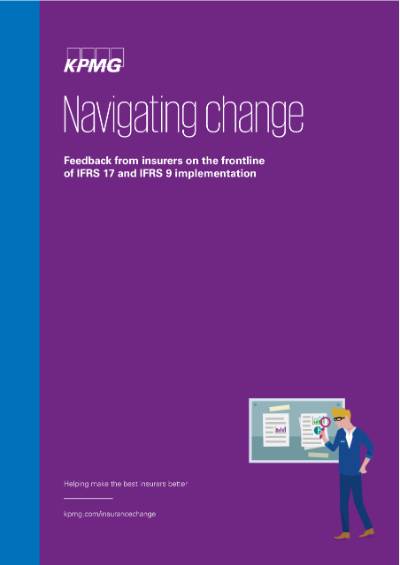Navigating change: Feedback from insurers on IFRS 17 and IFRS 9 implementation
Navigating change: Feedback from insurers
Insurers around the world share their progress, challenges and concerns implementing IFRS 17 and IFRS 9.

With the publication of IFRS 17, insurers are now embarking on a journey to implement and operationalize the new standard alongside IFRS 9. As we work with insurers to analyze what the standards mean for their business and how best to implement them, the one question we hear most often is, “how does my progress compare with my peers?”
To help answer this question and find out how well-prepared insurance companies are, we surveyed more than 80 insurance executives around the world to benchmark their readiness for IFRS 17 and IFRS 9 and examine how they are navigating change on the frontline. Respondents were drawn from 20 countries and include 15 of the 20 largest insurers in the Forbes 2017 Global 2000 that report using IFRS,
Where are insurers on their implementation journey?
A majority of insurers admit that they are still assessing, or have not yet begun their assessment for IFRS 17 (85 percent) and IFRS 9 (65 percent). However, almost six out of 10 are expecting one or two years of parallel running ahead of “going live” with IFRS 17 and IFRS 9 in 2021 - leaving not much time to thoroughly assess, design, and implement processes and system changes before the effective date.
Those who delay may find themselves forced to reply on interim processes and manual controls when they `go live', and likely to forgo the opportunity to be strategic and the efficiencies they may have achieved from the new standards or automated processes.
People, training and resources
For a change initiative of this scale and complexity, the cost of both internal and external resources can be substantial and are front-of-mind for many insurers. Yet, the scarcity of talent is of greater concern - 8 out of 10 respondents believe that securing people with the right skills is a significant challenge, while 6 out of 10 find securing the necessary financial budget to be challenging.
Training is certainly needed to ensure the business is aligned for the change and could help expand the internal resource pool. Instead of focusing on just the key staff, the transition of this magnitude requires a cultural change, where all layers of the organization will need to be trained to learn a whole new language to understand and explain the business results.
Data, systems and processes
Most respondents expect to implement new systems or to change existing systems to operationalize the new standards and to centralize and automate actuarial modeling systems. One of the most significant system challenges that insurers are facing for the first time is operationalizing Contractual Service Margin (CSM). Almost 6 out of 10 respondents have not yet decided if they would buy or build their CSM calculator, but this is an important decision underpinning the target finance architecture and needs to be made soon to meet made deadlines.
For companies yet to commence their analysis, our systematic approach in the publication can be useful as it illustrates the typical layers of an insurer's finance and actuarial systems and the impact of IFRS 17 on each layer of the systems.
Despite the scale of the challenges in implementing the new standards, two-thirds of companies are keen to seize the opportunity to transform their business in terms of systems modernization (47 percent), process optimization (45 percent) and actuarial transformation (45 percent). However, companies that are behind in their implementation efforts may soon realize they are running out of time and no longer have the scope to address operational challenges and hence reduce the potential benefits of their investments.
Conceptual challenges and business impacts
Our survey further shows that the extent of uncertainty is significant among insurer, citing the following conceptual challenges in implementing IFRS 17: determining the appropriate level of aggregation/onerous contracts, identifying data requirements including their granularity, difficulties with historical data, and transition including the impact on opening equity.
The number and complexity of the conceptual challenges are compounded by the extent of the business impacts that out respondents report, such as product design and pricing, cost allocation, investment policy and risk management.
The road to implementation is not easy, and the risks of delay are significant in terms of a shrinking talent pool, a more limited runway for systems integration, and forgoing the opportunity to be strategic in operationalizing the new standards to achieve greater efficiency.
Much needs to be achieved in three years and we are here to help.
Contact us or your local KPMG advisor to discuss our findings in more detail or find out how we can help you navigate your path forward and unlock value from the changes.


